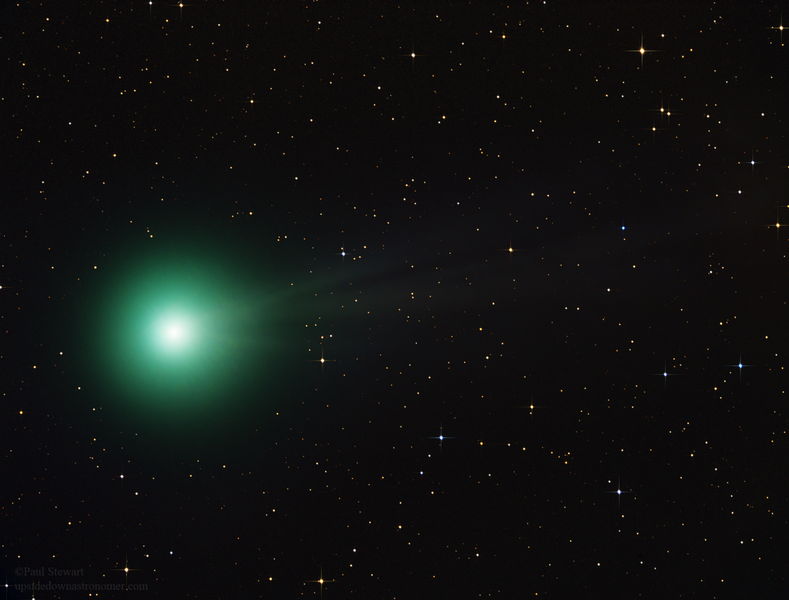
Photograph of Comet Lovejoy (C/2014 Q2) taken by Paul Stewart on 2014 December 27.
(Image Source: Wikipedia.org )
By Glenn A. Walsh
Reporting for SpaceWatchtower
Today (January 7 - Orthodox Christmas), Comet Lovejoy, discovered on 2014 August 17 by Australian amateur astronomer Terry Lovejoy, makes its closest approach to Earth. Today the comet is only 0.47 Astronomical Units (AU) from the Earth (70 million kilometers / 44 million statute miles); one A.U. equals the average distance between the Earth and the Sun (149,600,000 kilometers / 92,960,000 statute miles).
This also starts about a two-week period when the comet will be the most visible in the sky. The comet's closest approach to the Sun comes on January 30.
Although Comet Lovejoy is closest to the Earth today, light from the nearly Full Moon still makes it difficult to find. However, over the next two weeks, as the Moon rises an hour later each night, there is more time to find the comet in a darker sky.
Of course, city lights are also a problem when looking for Comet Lovejoy. It is best to get away from city lights, if possible, to find the comet.
Stars are pinpoints of light, while a comet is much more diffuse, shining by reflected light from the Sun. So, a star of a certain apparent visual magnitude is much easier to spot than the fuzzy head of a comet of the same magnitude.
On Monday, Comet Lovejoy had a reported apparent visual magnitude of ~ +4.4 to +5.0. Over the second and third weeks of January, the comet is expected to glow at around +4th magnitude. Under ideal conditions with no city lights and before Moon rise, the comet will be dimly visible to the naked-eyes. Binocular and telescope views of the comet should be easier, as long as one knows where to look for it.
In Astronomy, the apparent visual magnitude is the measurement of the apparent brightness of a celestial object seen by an observer on the Earth, if the Earth had no atmosphere. The lower the number (and negative numbers are considered lower than positive numbers), the brighter the object. The extreme naked-eye visibility limit is considered between magnitudes +7 and +8. Still, observing conditions have to be reasonably good to view a comet with the naked-eyes.
Currently, Comet Lovejoy is in the northern portion of the southern constellation of Eridanus, nearly 20 degrees west of the belt of Orion the Hunter, one of the classic Winter constellations. The comet continues moving north. Hence, as the moonlight becomes less of a problem each evening (the Moon rises about an hour later each night), the comet will be higher in the sky and should be easier to find.
Eridanus
Eridanus
As the comet moves north, and higher in the sky over the next two weeks, it will pass through the constellations of Taurus the Bull, Aries the Ram, and Triangulum. On January 17, Comet Lovejoy passes 8 degrees west-southwest of the Pleiades Star Cluster.
Although today is the closest to the Earth that the comet will reach, over the next days it is expected to get just a little brighter, as the comet gets higher in the sky, and as it gets closer to the Sun. However, by the end of the month, when it reaches its closest approach to the Sun, the brightness will start fading.
Triangulum
On Sunday, Europe's Virtual Telescope Project will provide a live, Internet web-cast of Comet Lovejoy, using one of their robotic telescopes. The web-cast will begin on January 11 at 2:00 p.m. EST / 19:00 Coordinated Universal Time (UTC) (an earlier web-cast occurred on January 6, which is archived on their web site).
Live, Internet Web-Cast of Comet Lovejoy, Jan. 11, 2:00 p.m. EST / 19:00 UTC:
Link >>> http://www.virtualtelescope.eu/webtv/
More about finding Comet Lovejoy, including a finder-chart (finder-chart at end of article):
Link >>> http://www.skyandtelescope.com/astronomy-news/observing-news/spot-comet-lovejoy-tonight-122920141/
More about Comet Lovejoy: Link >>> http://en.wikipedia.org/wiki/C/2014_Q2_%28Lovejoy%29
Related Blog Post ---
Meteor Shower & Comet Part of Busy Weekend in Astronomy (2015 Jan. 3):
Link >>> http://spacewatchtower.blogspot.com/2015/01/meteor-shower-comet-part-of-busy.html
Source: Glenn A. Walsh, Reporting for SpaceWatchtower, a project of Friends of the Zeiss.
Want to receive SpaceWatchtower blog posts in your inbox ?
Send request to < spacewatchtower@planetarium.cc >..
gaw
Glenn A. Walsh, Project Director,
Friends of the Zeiss < http://buhlplanetarium.tripod.com/fotz/ >
Electronic Mail - < gawalsh@planetarium.cc >
SpaceWatchtower Blog: < http://spacewatchtower.blogspot.com/ >
Also see: South Hills Backyard Astronomers Blog: < http://shbastronomers.blogspot.com/ >
Barnestormin: Writing, Essays, Pgh. News, & More: < http://www.barnestormin.blogspot.com/ >
About the SpaceWatchtower Editor / Author: < http://buhlplanetarium2.tripod.com/weblog/spacewatchtower/gaw/ >
SPACE & SCIENCE NEWS, ASTRONOMICAL CALENDAR:
< http://buhlplanetarium.tripod.
Twitter: < https://twitter.com/spacewatchtower >
Facebook: < http://www.facebook.com/pages/
Author of History Web Sites on the Internet --
* Buhl Planetarium, Pittsburgh:
< http://www.planetarium.
* Adler Planetarium, Chicago:
< http://adlerplanetarium.
* Astronomer, Educator, Optician John A. Brashear:
< http://johnbrashear.tripod.com >
* Andrew Carnegie & Carnegie Libraries:
< http://www.andrewcarnegie.
* Civil War Museum of Andrew Carnegie Free Library:
< http://garespypost.tripod.com >
* Duquesne Incline cable-car railway, Pittsburgh:
< http://inclinedplane.tripod.
* Public Transit:
< http://andrewcarnegie2.tripod.
Obat Kutil Kelamin
ReplyDeleteKondiloma akuminata atau yang sering disebut sebagai kutil kelamin, merupakan salah satu penyakit seksual menular (PMS) yang disebabkan oleh virus yang bernama Humanpapilloma virus (HPV). Terdapat lebih dari 40 jenis HPV yang dapat menginfeksi daerah kelamin laki-laki dan perempuan. Jenis HPV ini juga dapat menginfeksi mulut dan tenggorokan. Kebanyakan orang yang terinfeksi dengan HPV bahkan tidak tahu mereka memilikinya. HPV tidak sama dengan herpes atau HIV (AIDS).